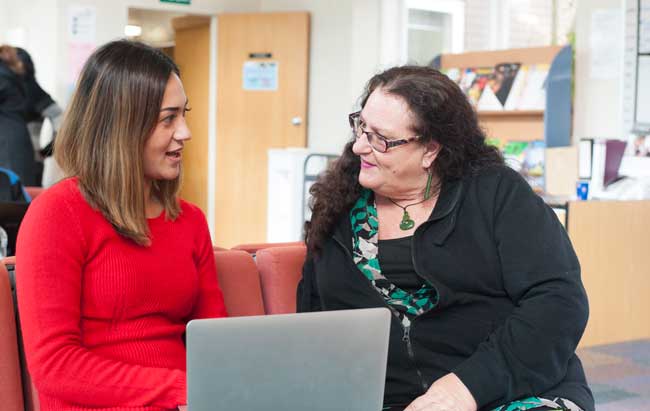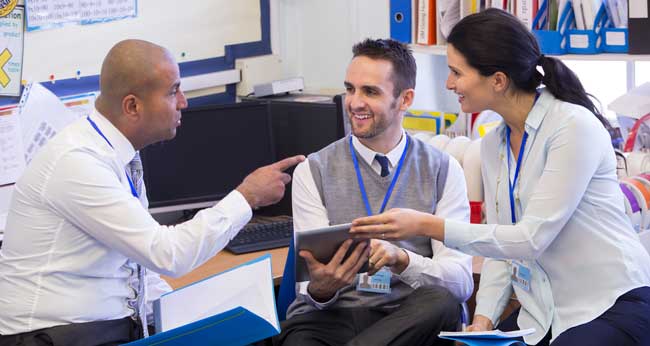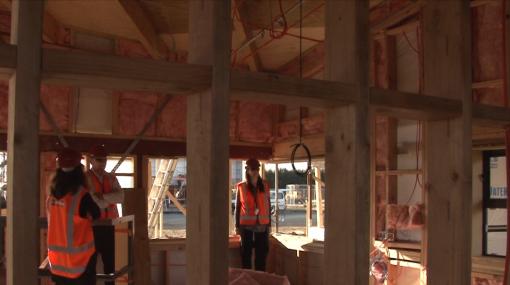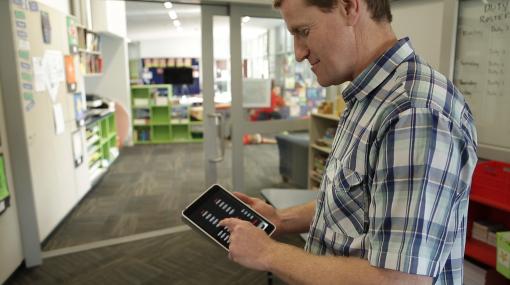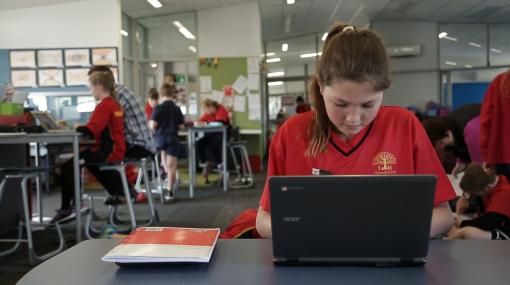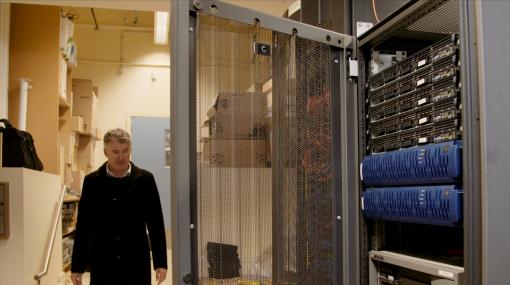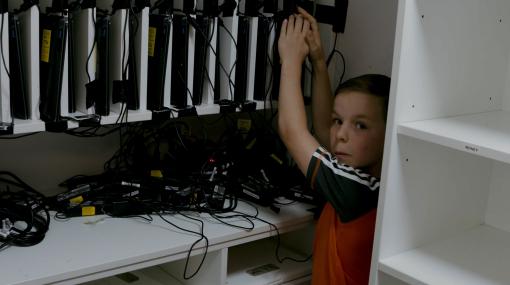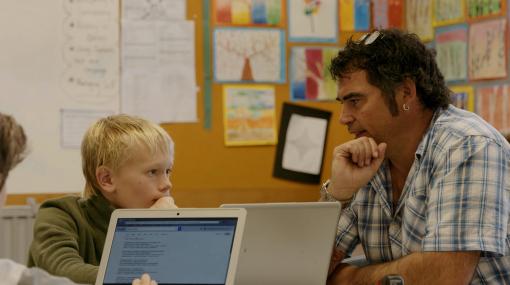Reviewing your school's technologies
Why review your school's technology
Reviewing your school’s technology as part of structured and deliberate planning is necessary because technology:
- impacts directly on teaching and learning
- is a rapidly evolving area
- directly affects your school’s administration
- is a significant financial cost to your school
- may involve staffing or contract considerations.
Using the eLPF to carry out an e-learning and e-capability self-review provides accurate information to support your school when planning and making decisions about:
- professional learning and development for staff
- supporting learners
- purchasing new technologies and developing school infrastructure.
Four major components of school technology
Infrastructure
All the parts that tie the network together including cabling, network switches, servers, and wireless access points.
Devices
All the equipment that staff and students use, such as projectors, TVs, phones, desktops, laptops, iPads, and Chromebooks.
Services
These run on your servers or in the cloud, for example, mobile device management, Google’s G Suite for Education, Microsoft Office 365, your student management system, library software, and your school website.
Software and apps
These run on your devices to make them useful.
Major changes to your school’s technology are likely to require significant planning and outside expertise to accomplish. Advanced notice of any potential changes from a regular review means fewer surprises and the ability to plan around any expense and disruption.
What is the purpose of your review?
A review of your school’s current technology determines whether it currently meets your learners’ needs. Combined with your school’s vision, it can also determine whether your technology will meet future needs. The review should identify if your technology is:
- fit for purpose
- robust
- reliable
- secure
- good value for money
- compliant with accepted standards and practices.
To get the maximum benefit from a review of your technology, it should be undertaken as part of a considered strategy for using digital technologies to improve learning.
The Strategic Thinking Roadmap and the e-Learning Planning Framework are useful resources that will help you to review and plan for how digital technologies are used in your school.
Types of review
A deliberate strategy for reviewing your technology should be in place:
- annually – to fit with your budgeting cycle
- every three years – as part of a broader strategic planning cycle
- after a significant technology-related event – which leads you to question its suitability for example, when new technology becomes readily available or following a cyber-security incident.
Annual review
The annual review is best conducted at a time that fits in with your budgeting cycle. Term two is often suitable to give enough time to gather information and costs ready for the next financial year.
The annual review should include:
- a report on the aspects of your technology that are working well and those that could be improved or added
- whether your current technologies will meet anticipated needs for the next year
- a quick "health-check" with regards to security, backups, and general system robustness
- whether your current technical support is meeting the needs of your school
- a financial summary and budget for the next year, along with budget predictions for years two and three.
Three-yearly review
The three-yearly review should consider if the general alignment of technologies will meet the future needs of your school. Items that your three-yearly review could consider include:
Robust digital infrastructure
- Are any of your existing servers, switches, or wireless access points due for replacement over the next few years?
- How will projected roll changes impact on your technical infrastructure?
- How will anticipated changes in curriculum provision impact on your technical infrastructure?
Digital Services
- Do your digital services meet your needs? Are alternatives available that have additional features, are more cost-effective, or are cloud-based to reduce the need for you to maintain on-site servers?
- How will projected roll changes impact on your needs?
- How will anticipated changes in curriculum provision impact on your digital services needs?
Software and apps
- What software and apps need to be upgraded, retired or replaced?
- What new software and apps are being requested?
- What new software and apps are available for consideration?
Significant technology-related event review
A significant event review tends to be of a narrower scope than a three-yearly review and may focus on a particular event or trigger such as:
- changes in key personnel or technical support
- significant technological improvements or opportunities
- end-of-life scenarios
- security breaches
- disaster events such as a fire, flood, hardware, or software failure.
A significant event review should enable you to answer the following questions:
- What has happened?
- What opportunities are being presented to you and what do you need to do to take advantage of them?
- Do you need any outside help with understanding the issues?
- What do you need to do to mitigate any future risk?
- How does the significant event change previous technology planning?
Discussion starters
Use the discussion starters in conjunction with the e-Learning Planning Framework to:
- identify your current school-wide systems
- support your planning to resource the successful use of digital technologies in learning and teaching.
This includes considering:
- responsibility and management
- equitable access for all to devices
- the environment
- reliability of devices
- safety and risk management.
Principals and school leaders
- How does your school environment and the physical layout of learning spaces reflect your vision for e-learning?
- How does your school-wide planning for infrastructure (budgeting, resourcing) align with your strategic direction?
- How will you ensure everyone in your school community has equitable and reliable access to e-learning tools and resources?
- How do you use technologies to plan, collect, share, analyse data, assess, and report?
- What are your needs for school administration, accounts, and your library system?
- What are your needs for using technologies to collaborate and engage with parents, whānau and your community?
Teachers
- What do you think effective management and use of technologies looks like? Consider equitable access, safety, and care.
- How familiar are you with your school's systems for the appropriate use of resources?
- To what extent can you model appropriate use of technologies for learning? Consider digital citizenship and building digital fluency.
- How might the physical layout and access to technologies in learning spaces reflect a collaborative, student-centred learning environment?
- How can you use technologies to collaborate and engage with parents, whānau and your community?
Carrying out your school review
There are several ways to carry out a review of your school’s technology. You will need to consider who does the review and how it is done.
Take a team approach
Just like any strategic planning process, a team approach is recommended as you identify your needs, create a plan, oversee the review and consider the implications. Having senior leadership involvement throughout the review process will help to ensure that it is part of the school’s overall strategic planning.
Ensure learning and teaching is a priority
The ability of technologies to support teaching and learning should be in the foreground of any review. This can be done by ensuring the review’s focus questions have a clear link back to learning and teaching and your school-wide strategic plan.
Who does the review
Your review can be done by one or more of:
- a knowledgeable person or group at your school
- a peer or group from another school
- your technical support provider
- an outside contractor.
Reviewers should declare any conflicts of interest, particularly if they have been involved in previous technology decisions, or could benefit from purchasing decisions made as a result of the review. Consider a peer review conducted with a knowledgeable person from another school or organisation. Peer reviews help build the capacity for good decision-making within your school’s community. No matter who does the review, the cost, if any, should be agreed beforehand.
How to carry out your review
Prior to the review, you will need to agree with stakeholders on a set of questions to be answered and what format the review will be in. The questions will be decided by the type of the review: annual, three-yearly, or significant event. These questions should be made explicit so that they can be referred back to. It is likely that the review team will need to gather data from several sources. These may include:
- accessing technical equipment and observing software/systems in use
- reading strategic plans and technical support documentation
- consulting key stakeholders:
- technical support providers
- school leaders
- teachers
- students
- parents/caregivers.
Review questions should link teaching and learning to technological systems, for example:
- Are teachers and students able to access technology when and where they need it?
- Are users confident that systems will be reliable enough to use regularly?
- Does the technology support your school’s vision for pedagogy?
Technology review template
Use the example technology review template to help plan your review. Items on the template are indicative of the areas that a technical review will typically cover. Particular circumstances (for example, purposes, priorities, and environment) will influence the details. While it is likely that each main area will apply, the details and questions that you answer will be specific to your situation and the template should be tailored accordingly. It is not intended as an exhaustive list of questions.
Your technical review should address:
- the current situation – Look for hard facts and evidence rather than assumptions and opinions, for example, “we measured it took 10 minutes to log in to a laptop”
- stakeholder expectations – This might be in terms of function, speed, ease of use, access, security, and efficiency, for example, “10 minutes to log in to a laptop is unacceptable”.
The technical review will include facts, figures, and findings pertinent to each area. It could include:
- inventories – makes, models, ages, specifications, warranty status
- test results – time taken to perform a task, security assessment
- video – demonstrating log-in performance
- logs – error logs
- diagrams – network diagram, performance charts
- survey results – staff and student surveys
- photos – hardware, screenshots.
The review report
The review report should be written up as succinctly as possible. The report should focus on the review questions, what evidence has been considered, and what the next steps should be. Solutions should be considered and recommendations justified. The report should be written in a way that a layperson can understand it.
Post-review decision making
Recommendations of the report should be considered in terms of impact on teaching and learning. To do this, it is important that stakeholders understand the report.
The report informs your school’s strategic planning and budgeting. This will require a set of actions to be managed in terms of people, costs, and time.
The nature of technology means some of the report’s recommendations may need immediate attention like security concerns or backups not working. Other recommendations may indicate longer-term projects.
Resources
The Ministry of Education's information about ways to maintain your upgraded ICT network and the Ministry’s programme of work.
The strategic thinking roadmap
This online guide will help your leadership team implement a strategic direction for integrating technologies school-wide for effective teaching and learning.
The e-Learning planning framework
These resources are designed to support you, and your school, in assessing and developing your e-capability.
Example technical audit template.pdf (PDF, 250.03 kB)
A series of questions to support your school audit process. These are organised into technical leadership, technical support and management, procurement, infrastructure, services, systems and applications, user-facing devices, and the user experience.
